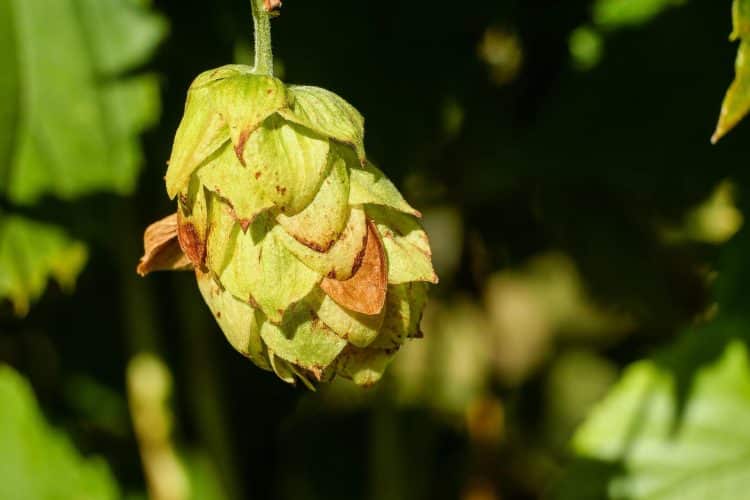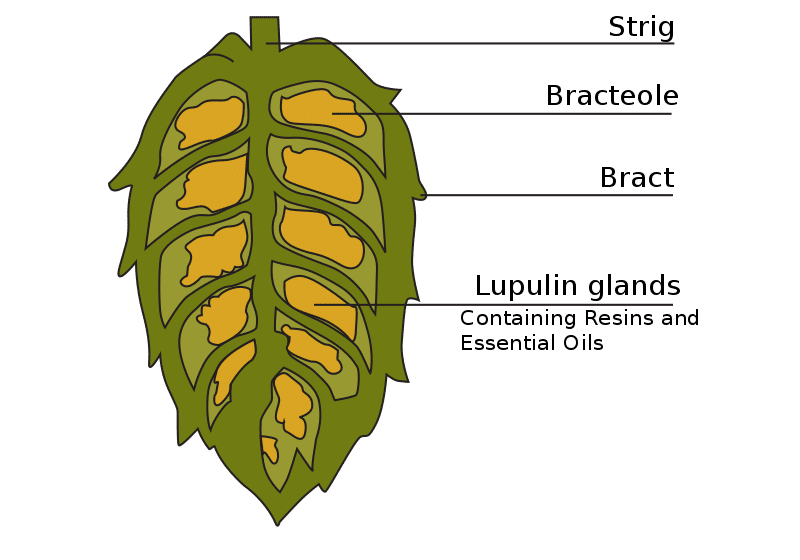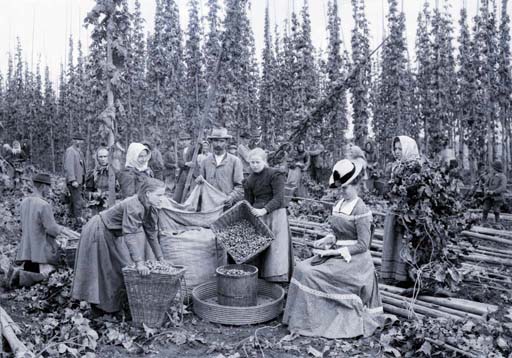Hop (Humulus lupulus) is a dioecious perennial plant with female flowers (“cones” or “hops”) that pack valuable phytochemicals. Most hop extracts—around 90%—serve the world’s breweries by lending fragrance, flavor, and stability to beer. [1] However, hops also offer a number of therapeutic benefits, and use of the flowers stretches back into history.
Diagram of a hop flower.
HerrSchnapps, Public Domain
The so-called craft beer revolution and demand for India Pale Ale (IPA) landed hops in the spotlight recently as a way for brewers to customize their product and satisfy consumers. [2] But European brewers (i.e., wet monasteries) were using hops about 1,200 years ago—at least, that’s the first recorded use as stated in an Abbot’s instructions for brewing. [3,4] By the 18th century, hops had become a dominant beer additive. [3] Today, hop extract is a staple ingredient in most beers, and there are many cultivars to emphasize distinct chemical profiles for products.
A hop harvest in Bohemia, 1898. František Krátký, Public Domain
The lupulin glands in hops hold the valued resin and oil; extract is well-suited for beer due to several phytochemicals [1]:
- Terpenes and terpenoids (e.g., limonene)
- α-acids (e.g., humulone)
- β-acids (e.g., lupulone)
- Phenolic compounds (e.g., quercetin)
Terpenes are known for aroma and flavor but, as with cousin plant Cannabis sativa L., may affect the consumer in other significant ways. α-Acids add bitterness but are also associated with foam stability. Sanz et al [1] explain that phenolics exert a “complex role on beer quality, contributing to mouthfeel, astringency and color, and…impact on the perceived bitterness character.” Along with terpenes, phenols infuse antimicrobial, antioxidant, and other stabilizing properties. [1]
Hops therefore house numerous bioactive agents applicable to medicine. Karabín et al [5] theorize that medicinal use dates back at least 2,000 years. Medieval manuscripts note that hops combat inflammation, ear infection, and indigestion (although most records focus on brewing). [5] A 1919 book from England describes “decoctions and syrups of hop-flowers or cones used for pestilential fever, scurvy, [etc.].” However, the main use was “soporific,” or promoting drowsiness. [6]
Hops are known for sedative and sleep-improving effects and have been suggested as a possible agent to treat insomnia. [5] Various molecules from hop extract—α-acids, xanthohymol (a flavonoid), and linalool, for example—have been implicated in this effect due to acting on GABA ( γ-aminobutyric acid) receptors in the brain. [5] Hop extract has thus established a presence in over-the-counter sleep aids and herbal products. Many of the individual components of hops (e.g., terpenes) have also been studied for therapeutic applications.
Though relatively safe for humans, hops are considered toxic to dogs and cats. Furthermore, the extract may promote estrogenic effects with possible consequences for individuals suffering certain sensitive conditions. [7] On the other hand, this same activity may be beneficial in alleviating hormonal disturbances for other individuals. [5]
Overall, hop extract remains the star ingredient in beer and contributes to its sedative effects. Given its long history and popularity, that probably won’t change anytime soon.
References
- Sanz V, et al. What is new on the hop extraction? Trends in Food Science & Technology. 2019;93:12-22. [Impact Factor: 8.519; Times Cited: 1]
- Kerckhoven SV, et al. The dynamics of the hops industry. In: Madsen ES, et al, eds. New Developments in the Brewing Industry: The Role of Institutions and Ownership. Oxford, UK: Oxford University Press; 2020.
- Behre KE. The history of beer additives in Europe — A review. Vegetation History and Archaeobotany. 1999;8(1-2):35–48.doi:10.1007/bf02042841 [Impact Factor: 2.364; Times Cited: 79]
- Meussdoerffer FG. A comprehensive history of beer brewing. In: Eßlinger HM, ed. Handbook of Brewing: Processes, Technology, Markets. Freiberg, Germany: WILEY-VCH; 2009.
- Karabín M, et al. Biologically active compounds from hops and prospects for their use. Compr Rev Food Sci Food Saf. 2016;15(3):542-567. doi:10.1111/1541-4337.12201 [Impact Factor: 9.912; Times Cited: 54]
- Clinch G. English Hops: A History of Cultivation and Preparation for the Market from the Earliest Times. London: McCorquodale; 1919.
- van Hunsel FP, et al. [Postmenopausal bleeding and dietary supplements: a possible causal relationship with hop- and soy-containing preparations]. Ned Tijdschr Geneeskd. 2012;156(41):A5095. [Impact Factor: N/A; Times Cited: 6]













